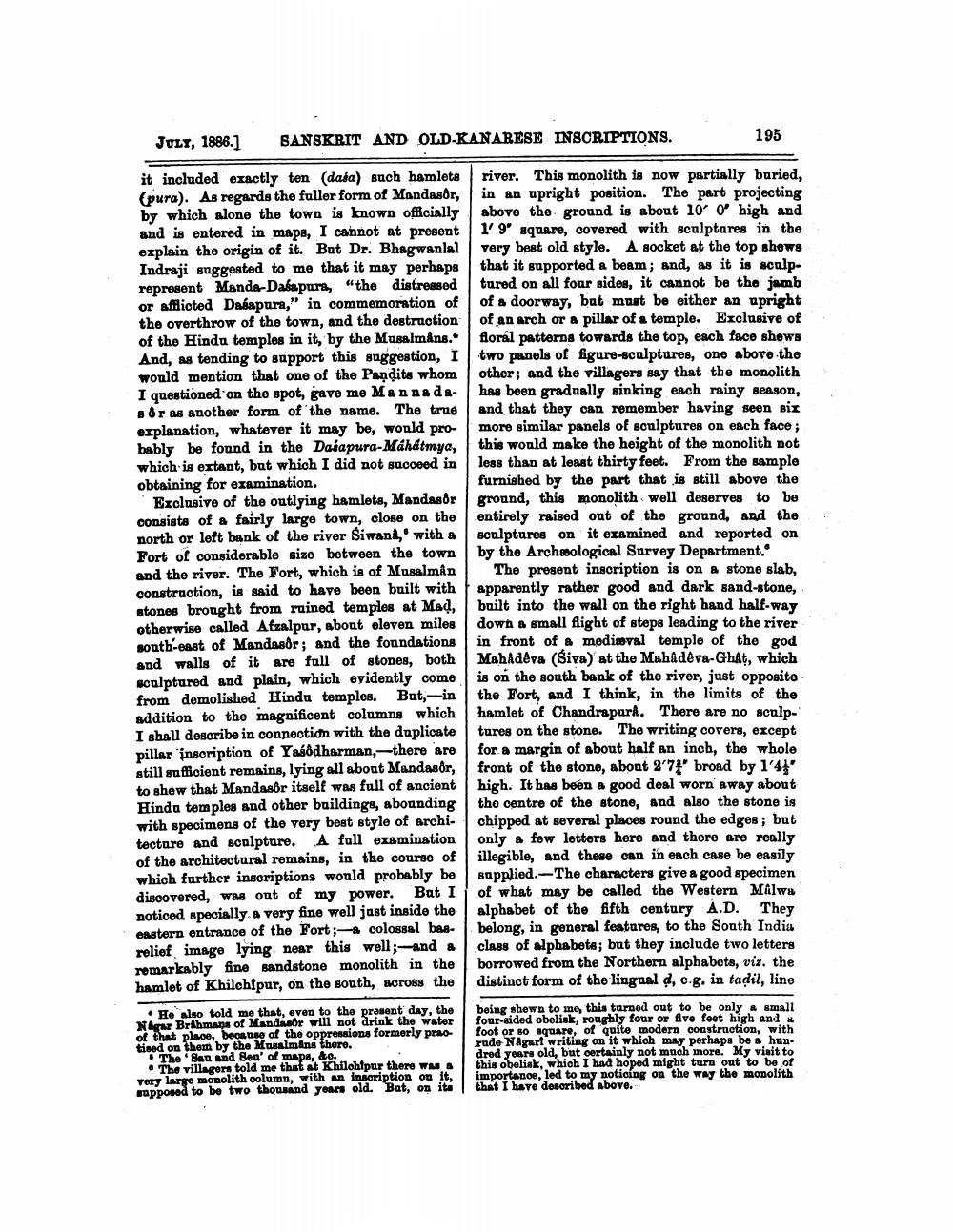________________
JULY, 1886.]
SANSKRIT AND OLD-KANARESE INSCRIPTIONS.
195
it included exactly ten (daba) such hamlete river. This monolith is now partially buried, pura). As regards the fuller form of Mandasôr, in an upright position. The part projecting by which alone the town is known officially | above the ground is about 10' 0high and and is entered in maps, I cannot at present | 1' 9' square, covered with sculptures in the explain the origin of it. But Dr. Bhagwanlal very best old style. A socket at the top shows Indraji suggested to me that it may perhaps that it supported a beam; and, as it is sculprepresent Manda-Dalapura, “the distressed tured on all four sides, it cannot be the jamb or afflicted Dasapura," in commemoration of of a doorway, bat must be either an upright the overthrow of the town, and the destruction of an arch or a pillar of a temple. Exclusive of of the Hindu temples in it, by the Musalmans. floral patterns towards the top, each face shows And, as tending to support this enggestion, I two panels of figure-sculptures, one above the would mention that one of the Pandits whom other; and the villagers say that the monolith I questioned on the spot, gave me Mannada- has been gradually sinking each rainy season,
Or as another form of the name. The true and that they can remember having seen six explanation, whatever it may be, wonld pro- more similar panels of sculptures on each face ; bably be found in the Dasapura-Máhatmya, this would make the height of the monolith not which is extant, but which I did not succeed in less than at least thirty feet. From the sample obtaining for examination.
furnished by the part that is still above the Exclusive of the outlying hamlets, Mandagor | ground, this monolith well deserves to be consists of a fairly large town, close on the entirely raised out of the ground, and the north or left bank of the river Siwand, with a sculptures on it examined and reported on Fort of considerable size between the town by the Archeological Survey Department. and the river. The Fort, which is of Musalman The present inscription is on a stone slab, construction, is said to have been built with apparently rather good and dark sand-stone, stones brought from ruined temples at Mad, built into the wall on the right hand half-way otherwise called Afzalpur, about eleven miles down a small flight of steps leading to the river sonth-east of Mandasör; and the foundations in front of a mediwval temple of the god and walls of it are full of stones, both Mahadeva (Śiva) at the Mahadeva-Ghật, which sculptured and plain, which evidently come is on the south bank of the river, just opposite from demolished Hindu temples. But,-in the Fort, and I think, in the limits of the addition to the magnificent columns which hamlot of Chandrapura. There are no sculpI shall describe in connection with the duplicate tures on the stone. The writing covers, except pillar inscription of Yaddharman, there are for a margin of about half an inch, the whole still sufficient remains, lying all about Mandasör, front of the stone, about 2'7*' broad by 1:43 to shew that Mandasor itself was full of ancient high. It has been a good deal worn away about Hindu temples and other buildings, abounding tho centre of the stone, and also the stone is with specimens of the very best style of archi- chipped at several places round the edges; but tecture and sculpture. A full examination only a few letters here and there are really of the architectural remains, in the course of illegible, and these can in each case be easily which further inscriptions would probably be sapplied. The characters give a good specimen discovered, was out of my power. But I of what may be called the Western Malws noticed specially a very fine well just inside the alphabet of the fifth century A.D. They eastern entrance of the Fort; colossal bas. belong, in general features, to the South India relief image lying near this well; -and a class of alphabete; but they include two letters romarkably fine sandstone monolith in the borrowed from the Northern alphabets, vis. the hamlet of Khilchipur, on the south, across the distinct form of the lingual d, e.g. in tadil, line
• He also told me that, even to the prasent day, the being shown to me, this turned out to be only a small Nlqar Brahmans of Mandasor will not drink the water four-sided obelisk, roughly four or five foet high and of that place, because of the oppressions formerly prao foot or so aquare, of quite modern construction, with tised on them by the Musalmans there.
rade NAgart writing on it which may perhaps be a hunThe 'San And Beu' of mapa, &o.
dred years old, but oertainly not much more. My visit to • The villagers told me that at Khilohtpur there was this obelisk, which I had hoped might turn out to be of very large monolith column, with an inscription on it, importance, led to my noticing on the way the monolith rapposed to be two thousand years old. But, on ito that I have described above.




